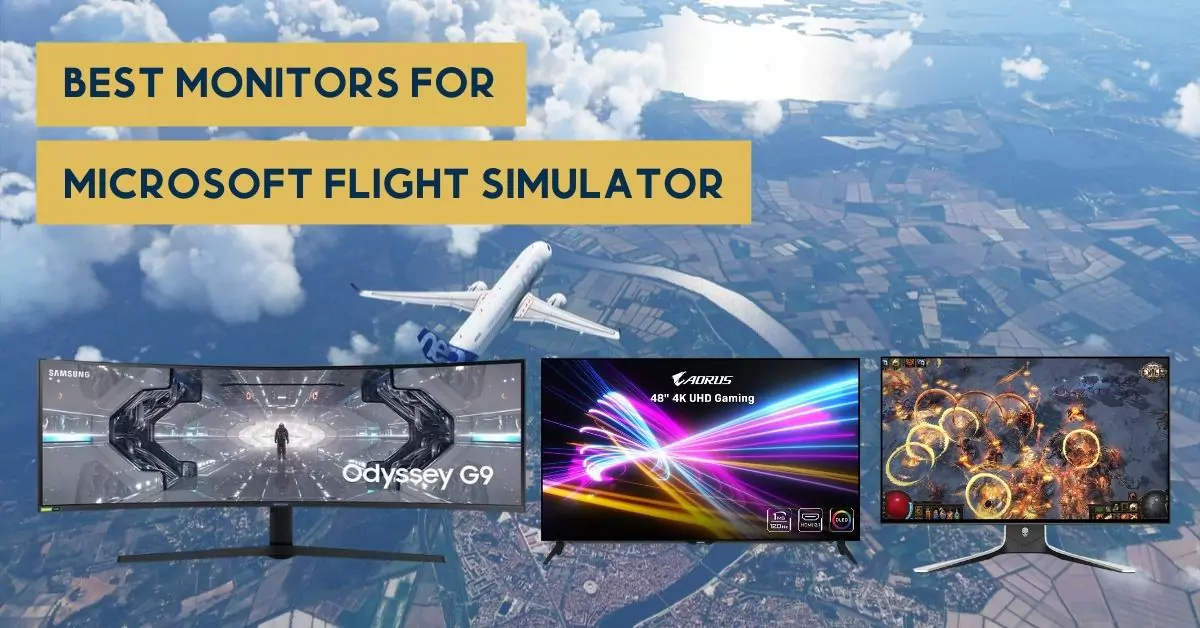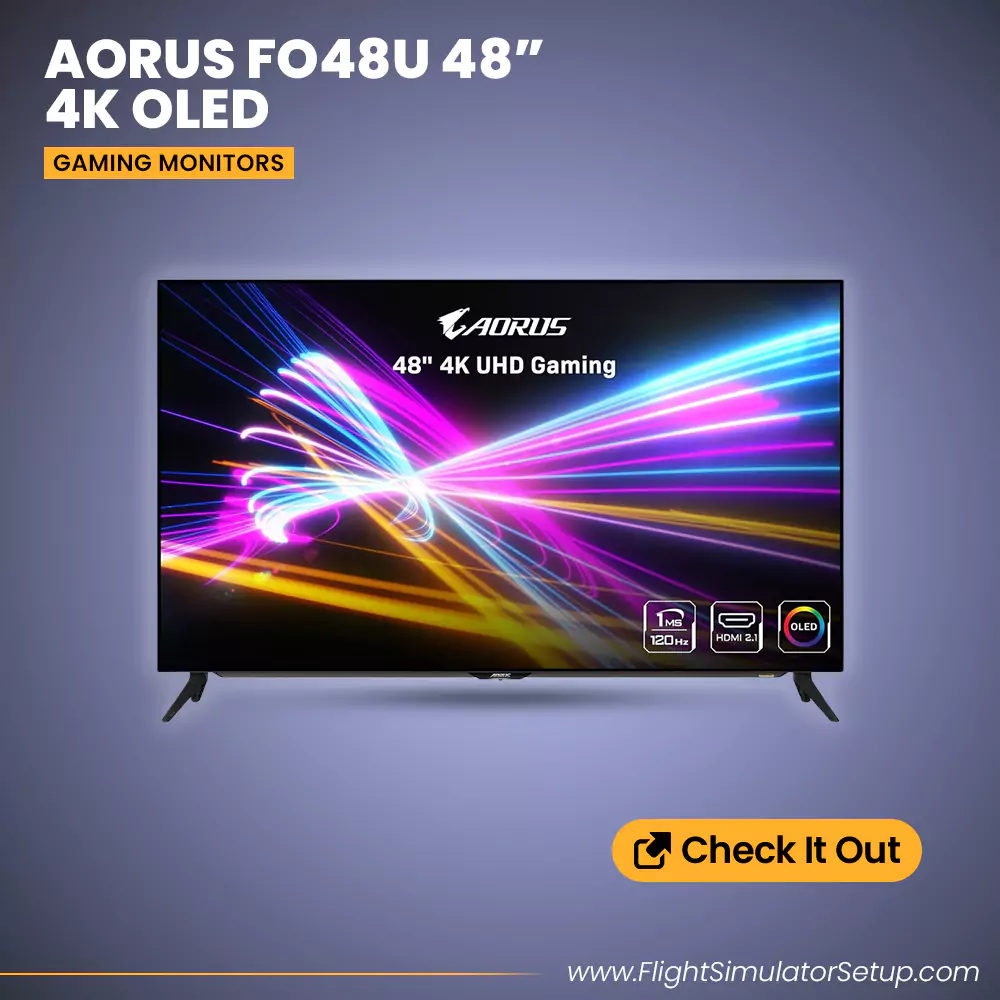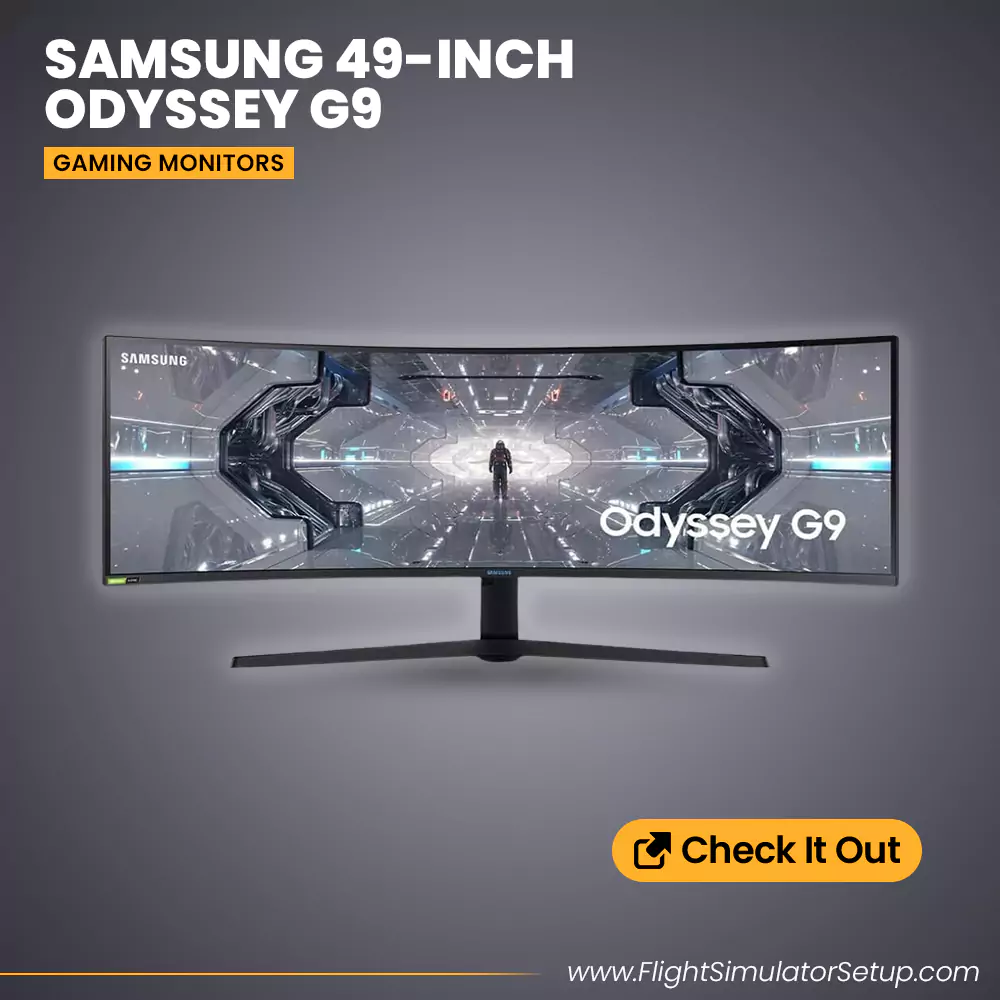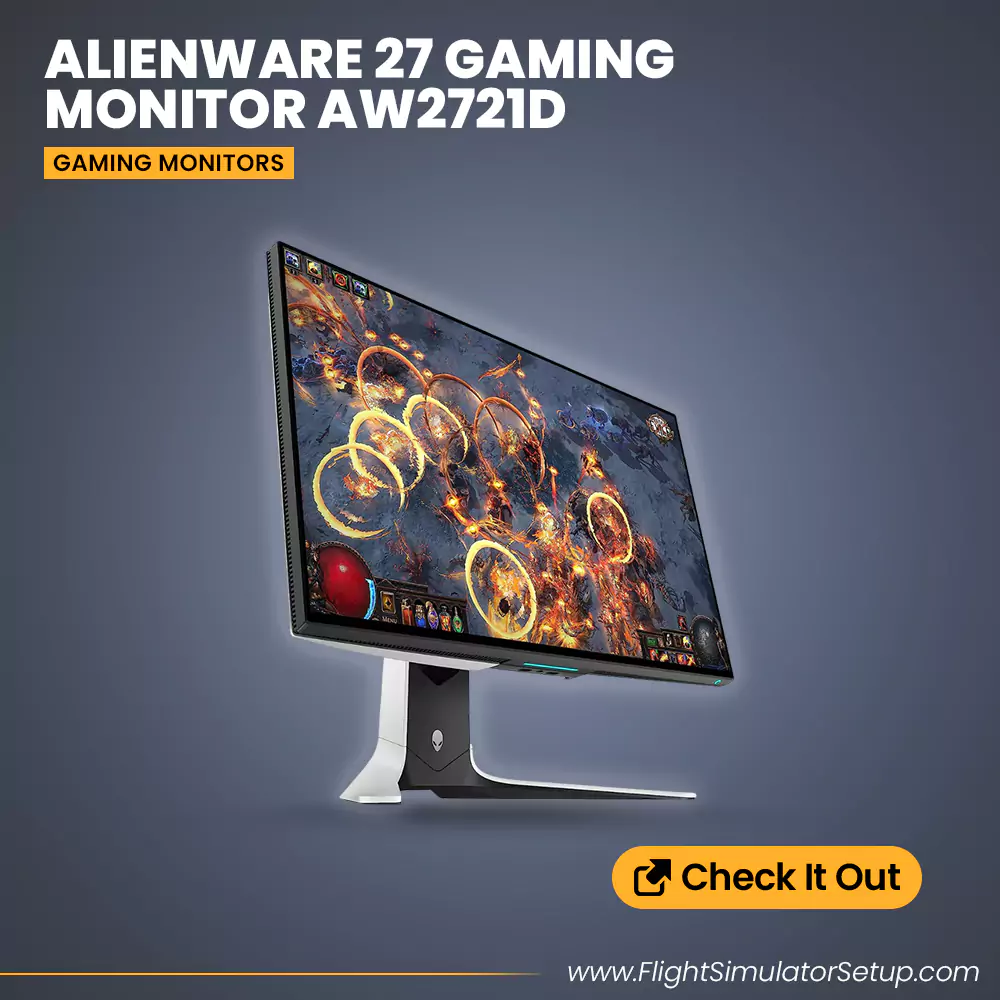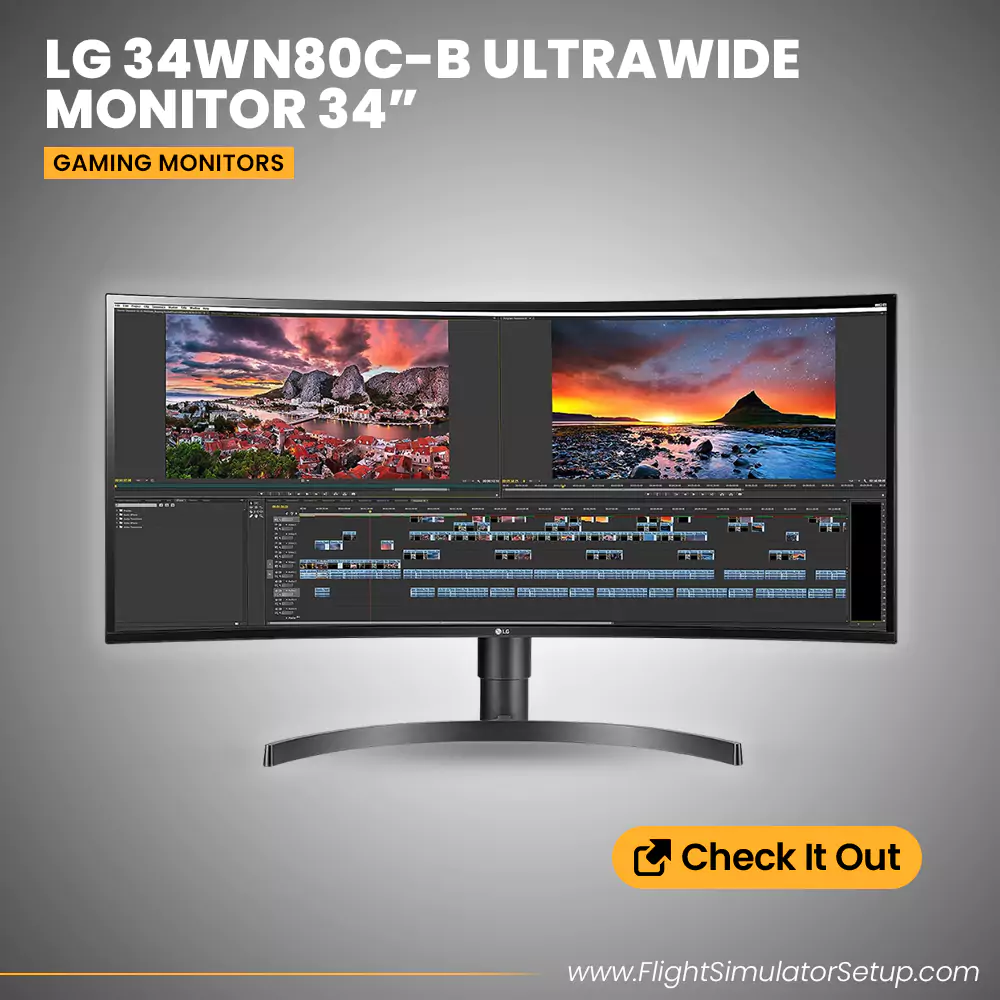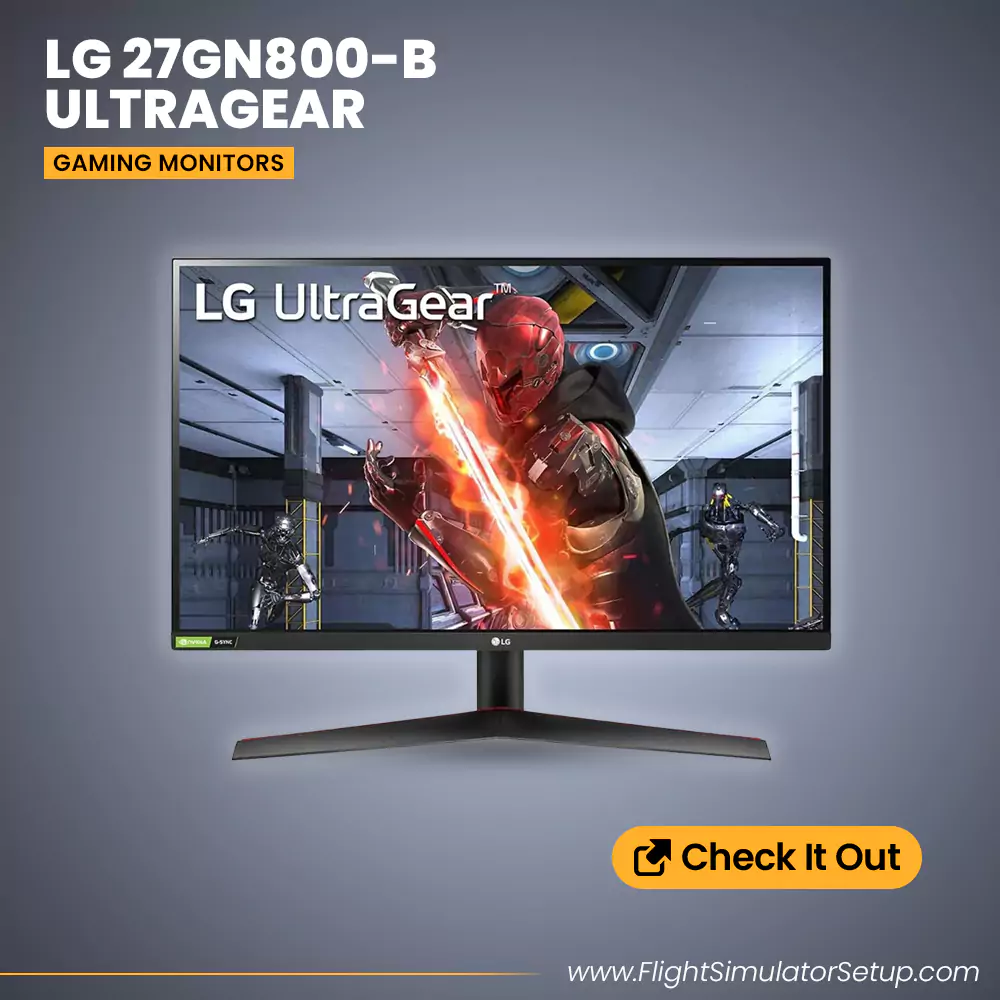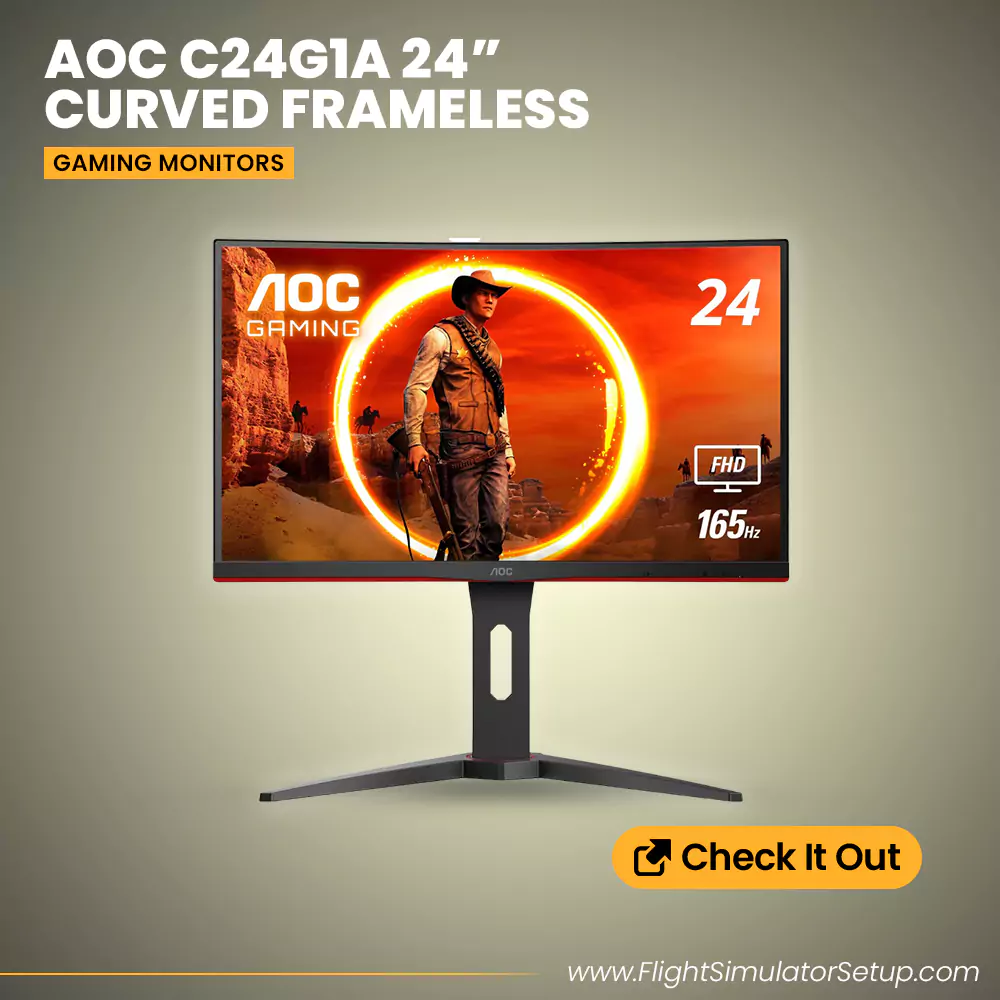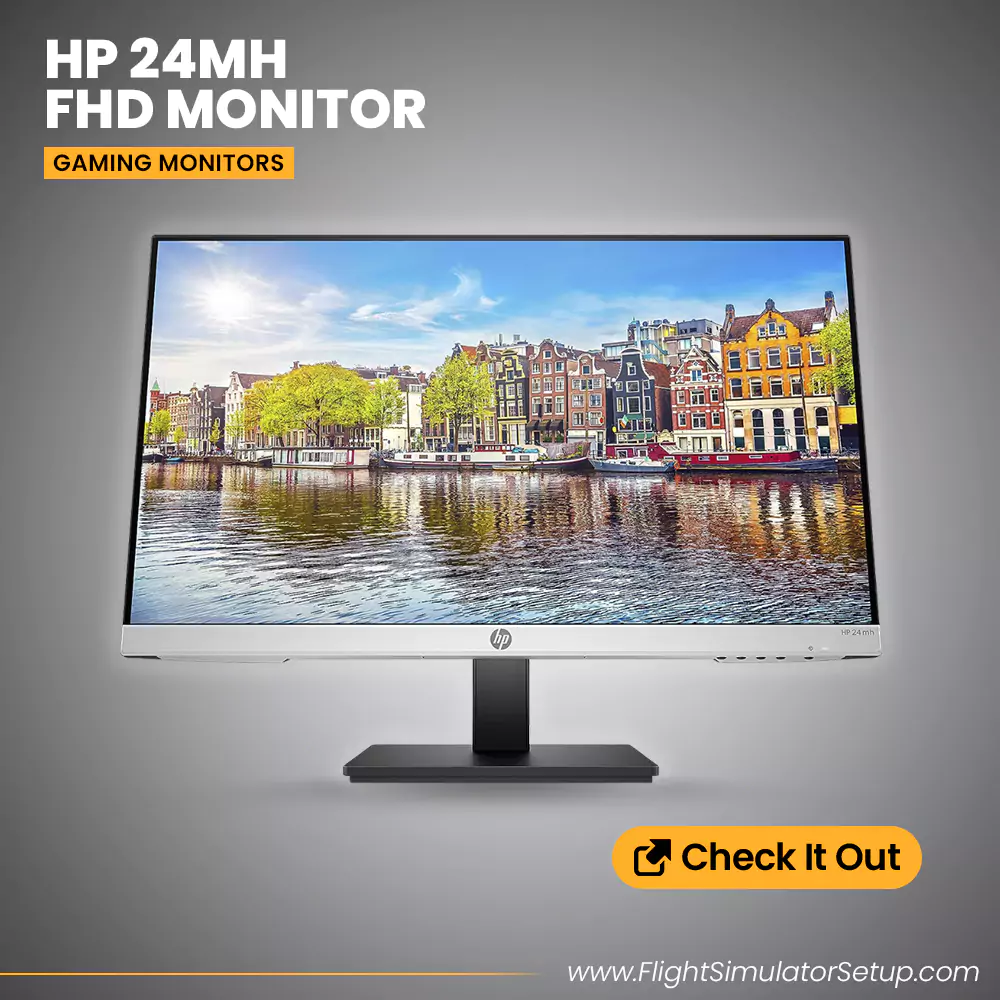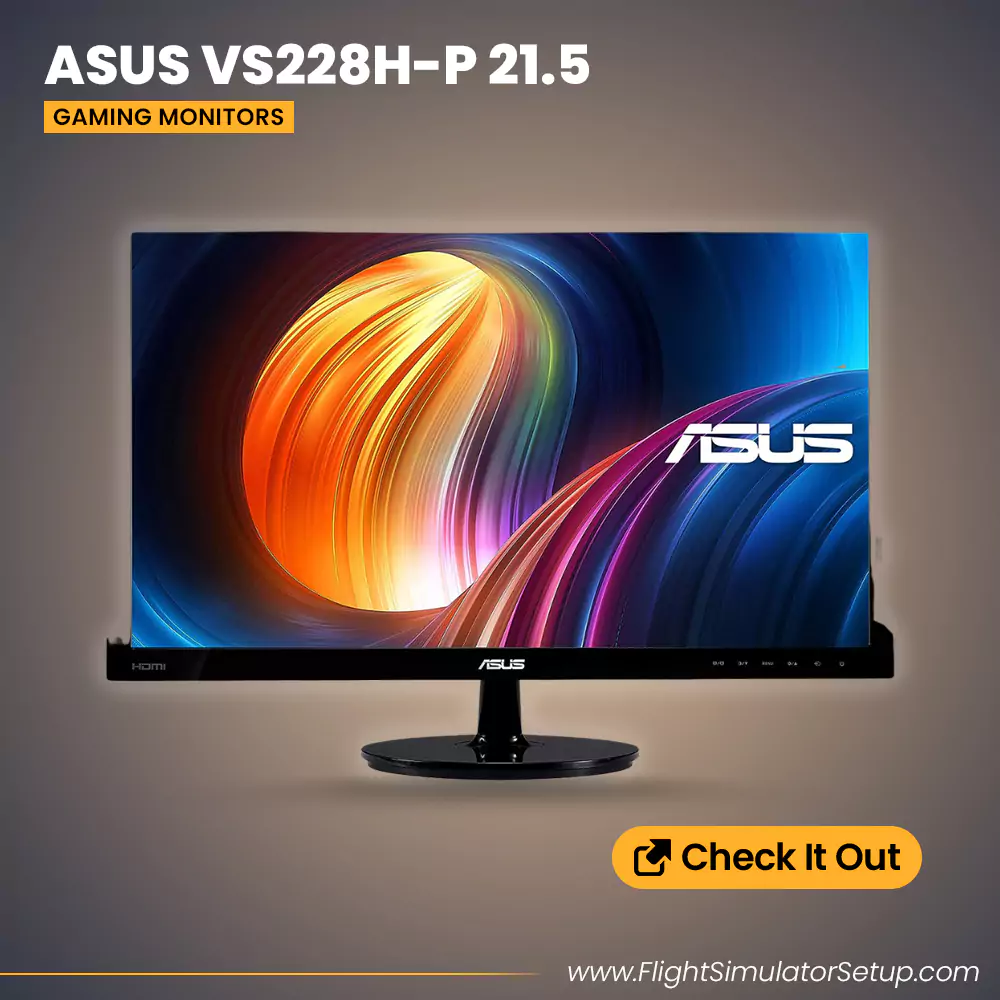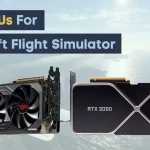Immerse yourself in the skies with MSFS 2020, a game that has set a new standard for virtual aviation. To fully appreciate the meticulous detail and stunning visuals of this game, you need the best monitor for Microsoft Flight Simulator 2020. A game that has been painstakingly crafted, it deserves to be paired with hardware that enhances every pixel to its fullest potential.
Your gaming PC’s prowess is undeniably important, but the right monitor is a game-changer. It’s the portal to the game’s expansive environments, and without the right one, you might as well be flying blind. If you’re on the hunt for an upgrade or a new addition that complements your gaming achievements, look no further. We’ve invested the time so you don’t have to, creating a comprehensive guide to the best monitors tailored for Flight Simulator 2020.
Explore the Best Monitors for Microsoft Flight Simulator 2020
The market is rife with quality monitors that will service your needs for Microsoft Flight Simulator 2020. Our research concluded that the following 8 monitors cover a wide range of user needs and should deliver on whatever expectations you have from a Flight Simulator experience.
You may have noticed that this article did not have an OLED display until this point. That’s because OLED in monitor and even TV screens is quite a novelty. The few that do exist cost a lot more than IPS or even QLED panels and arguably do not offer a substantial enough jump to justify buying. That being said, there’s always someone looking for a novelty piece, and that someone might just be you. If you’re familiar with OLED panels, you already know about their excellent contrast ratios, their deep blacks, fantastic colors, and better viewing angles than many competitor technologies. You get all of that with the AORUS FO48U.
This monitor is also as bezel-less as any, maybe more. It’ll look like a mirror on your desk when its not on. Of course, if it looks like a TV it kind of has to act like one too. You get speakers with space audio and a pair of HDMI 2.1 ports that’ll work seamlessly with your Xbox Series S or X consoles running Microsoft Flight Simulator. OLED displays inevitably get some burn in with repeated and eventual use. If you plan on using your next monitor purchase for a long, long time, an OLED display may just fall short of your expectations.
It’s no secret that airplane windshields are pretty big, and if you pretend you’re in the cockpit for a second, the Odyssey G9 will probably have you believe you’re flying an actual plane. This monitor is HUGE. We do not want to undersell how ridiculously, freakishly large the Odyssey G9 is. It’s comically big. If you have this on your desk, you’re going to do more than just turn some heads and raise some eyebrows. It is as much a conversation starter as it is a functional ultra-wide monitor.
The screen gets pretty bright, and colors are excellent. With QLED technology, you also get better contrast than IPS or VA displays. NVIDIA’s G-Sync adaptive sync technology comes correct too, with virtually no tearing. For the price you’d probably expect that too, so enough about how good the display is. We were a little taken aback when we recognized that the input lag is nothing special at all. At 60Hz it goes as high as 17ms, but even if you’re using the native 240Hz output, it clocks in at around 4.4ms. This is definitely not something we appreciate given how much this monitor costs. All that being said, you could literally not go more overkill for a monitor you need for Microsoft Flight Simulator 2020
3. Alienware 27 Gaming Monitor AW2721D
Best 240Hz Monitor for Microsoft Flight Simulator
- Screen Size: 27”
- Resolution: 2560 x 1440
- Refresh Rate / Response Time: 240 Hz / 1 ms
- Display Type: IPS
- I/O ports: HDMI 2.0 Port, DisplayPort 1.4, 2 SuperSpeed USB 3.2 Gen 1 (5 Gbps) Downstream Ports with Power Charging, Headphone-Out Jack, 2 SuperSpeed USB 3.2 Gen 1 (5 Gbps) Upstream Ports, Audio Line Out Jack
Alienware have been the go-to Gaming brand for hardcore gamers and more casual fans alike. Wherever you fall on the spectrum, there’s a good chance any Alienware appliance will be right up your alley. The AW2721D certainly wowed us with basically everything it threw at us.
Let’s address the elephant in the room: the design. Even though it’s clearly designed to be a gaming peripheral, with its signature Alienware spaceship theme going on, we feel the design is muted enough to fit comfortably into any setup. There’s a singular blue light bar running down the middle to add to the glowing Alienware logo on the upper right. On the front you’ll find a flat, Quad-HD IPS display and no controls! This makes the front look like a seamless panel of glass, like an airplane’s windshield, and is fantastic for immersion.
You won’t have many complaints with the picture quality. Good sharpness, vivid colors and a display that gets plenty bright make it a clear upgrade over the monitors we’ve mentioned before. The HDR is a significant upgrade over the LG too. Not only does it meet usual HDR standards, but it also allows you to change the colors while using HDR to make for the best quality picture possible finetuned to your liking. On paper it’s actually sounding pretty close to perfect right? Almost.
While there is an incredible amount of I/O in this device, the ports are situated such that they are likely to bend or damage your cables over time. Also, if you’re looking to play Microsoft Flight Simulator on your Xbox Series S or X console through a 4K signal, as of the time of writing this article, the monitor does NOT support it. It will not downscale the settings to 1440p (the native resolution of this monitor) but will instead display 1080p.
If this were an article about any other video game, we would probably have skipped on the LG 34WN80C-B. It’s only 60 Hz, and you don’t really need a monitor this wide to enhance your experience for a lot of games. And for your what this goes for, you could get a top-of-the-line IPS gaming monitor no sweat. But this is an article about the best monitors for Microsoft Flight Simulator 2020, so naturally this was a surefire inclusion. Sitting at 34”, this might take up some desk space, but in return it will offer near unparalleled immersion with Microsoft Flight Simulator. Flight Sim is definitely a game that encourages maximum screen real estate for a heightened gameplay experience. If it isn’t obvious already, the LG with all 34 inches of screen does exactly that.
This is not advertised as a gaming monitor, and that’s because it is not. Really, it’s a monitor for productivity enthusiasts. More specifically, it’s a great buy for photo or video professionals or anything that requires use of a timeline. In that, it also sports a decent display. You get great visuals and colors as you’d expect, with HDR 10 support. It’s not the sharpest of displays though, and we suspect that the Anti-Glare coating might have something to do with that.
LG are surprisingly underrated when it comes to monitor displays. Dare we say, they’re almost unheard of in this category despite how well known the company is otherwise. Nevertheless, their quality manufacturing talents are on full display with the 27GN800-B. While it looks quite unassuming from the front, one look at the back tells you LG did their research on their target demographic. You’re immediately greeted by red accents and a large circular dial, which houses the I/O. You get a DisplayPort, two HDMI ports and even a USB 3.0 port to charge your devices. As is the norm at this price point, the monitor is basically frameless too.
The LG is NVIDIA G-Sync compatible, and you’ll be glad to hear the implementation is a lot better done here compared to the AOC. We’re huge fans of the color accuracy and response time in particular. Everything not only looks great but also, controls are responsive, and it makes for a stellar gaming experience. Our biggest gripe with this monitor is it’s HDR10 claims. While yes, the monitor DOES technically support HDR, it is just not bright enough to take full advantage of it. Clocking in at about 350 nits, it definitely falls short of the recommended 1000 nits standard for an HDR rating.
AOC brings all of the buttery smooth goodness of 144 Hz to a price point a lot of people can get down with. One look at the AOC C24G1A tells you it was designed with gaming in mind, making it not only a top monitor choice for Microsoft Flight Simulator 2020, but also virtually any other game you can think of. Red accents compliment the matte black exterior very nicely, and don’t come off as tacky as some other gaming centered peripherals might. You also get a curved screen here, which is a welcome addition at this price point and we’re definitely big fans of curved displays here. Plus, the thin bezels and curved nature of the display make it easy to add another identical monitor to your setup. You also get an additional HDMI port so you can hook up both your Gaming Rig and your Xbox Series S or X console to your monitor for all your Microsoft Flight Simulator 2020 needs.
The monitor’s refresh rate is indubitably its biggest selling point. And it’s not some run of the mill cranked up refresh rate technology either, AOC bought AMD’s FreeSync Premium technology to ensure the best quality high refresh rate experience. That being said, sometimes the implementation is a little suspect with flickering and synchronization. Using your computer will be a total breeze just in general, but if you have the resources to amp up Flight Simulator at 120fps you’re going to have a blast playing on the AOC C24G1A. We do have our reservations with the display quality in general though. While the display is definitely serviceable overall, the truth is this VA panel does not compare to an IPS display. This is definitely noticeable with colors and some ghosting. It’s clear that you’re making a tradeoff here, more frames for screen quality. But if that’s what you’re going for, the AOC does its job quite nicely and saves you some money to top. A clear winner in this price range.
Ok, lets just set it straight. This is, in our opinion, the best value IPS monitor on this list. For a little more than the ASUS budget option, you get a lot in terms of upgrades. For starters this is virtually a borderless monitor. To top that, it’s also a really slim design. These traits put together make it the perfect option for a dual or multi monitor setup. And that really is a sound idea when it comes to Microsoft Flight Simulator 2020, cause the more screen real estate you have, the more immersive your gaming experience. This HP 24mh is also height and tilt adjustable right out of the box. You don’t need to get a whole new monitor arm just to rotate your display now, but you definitely do have the option to do so with VESA mounting support.
We’re very much impressed with the display quality of the 24mh, especially in light of its price tag. As you’d expect from an IPS display, colors are decent, viewing angles are actually pretty good and all of that makes for a pleasant viewing experience. It could be a little sharper though, and unless you crank up the settings to the max, you’ll feel there’s a little left to be desired. Did we mention this unit also comes with a set of speakers? While the audio quality doesn’t exactly hold a candle to the Bang & Olufsens and the Sennheisers of the world, they’re still very much usable and hold great utility. No longer do you need to have a headphone set connected to your device for your audio needs or buy a separate pair of stereo speakers for that matter. Should you want to do that though, you totally can. Amongst the usual I/O offerings you also get an Audio port. The inclusion of a DisplayPort is also very welcome.
This ASUS budget entry tries its best to accommodate the user with the essential modern day monitor experience at a very affordable price without cutting too many corners. It’s cased in a sleek black frame and while yes, the thick bezels leave a little to be desired, you’ll find bigger abominations at a higher price point. At the back, you’ll find a variety of I/O including HDMI, DVI and VGA ports. Definitely a nice touch, seeing how even more expensive monitors cheap out on including HDMI ports sometimes. This means not only can you count on the monitor to support HD output from your PC or laptop, but also your Xbox Series X or S consoles which can also run Microsoft Flight Simulator 2020. Up to 75 Hz on a monitor at this price point is also pretty solid, and you’ll forgive me for being a little repetitive but again, you could go double the money and still only have 60Hz. Oh, and also this is VESA Mount Compatible for Wall Mounting or Monitor Arms. Meaning, you could definitely mod it up a little and have it set up to your liking.
The colors and viewing angles definitely leave a little to be desired though. This is neither the sharpest looking display nor the most color accurate. The backlighting means that the light will at times bleed out as well, which isn’t very aesthetically pleasing while using it in the dark. The build quality is also a little suspect, this isn’t exactly meant to take a beating with its all-plastic build. All of that can absolutely be forgiven once you understand that this is a very affordable unit. If you’re on a budget, or if the highest quality display isn’t exactly a priority for you, then this is the best budget monitor for Microsoft Flight Simulator 2020.
The Buyer’s Guide to the Best Monitor for Microsoft Flight Simulator 2020
Buying the best monitor for Flight Simulator isn’t as easy as your ABCs. There are actually several factors you need to take into consideration before you splash the cash on a new screen. After all, wouldn’t you want to make the best-informed decision so you can apply the knowledge to other monitors if you feel like it? This would also help to make sure you can get the best experience with a monitor running Flight Simulator. From screen size all the way down to price, here’s everything you need to know about buying monitors for Microsoft Flight Simulator 2020.
Screen Size
24 inches seems to be the sweet spot for most people. And why wouldn’t it? We’re of the opinion that monitors this big is the perfect buy for just about anyone. They would comfortably sit atop a normal sized desk, but even if your table is a little roomier, they’d easily be the centerpiece of a tabletop setup. Fun fact: we wrote this article on a 24-inch monitor too! That’s not to say smaller or larger screen sizes don’t have their merits. Ultra-wide screens seem to be all the rage these days, and often times you’ll find they exceed the 24-inch standard. Likewise, 21-inch screens are another very popular form factor for people looking for something a little smaller for their needs.
Screen Resolution
Let’s be honest, 720p just doesn’t cut it anymore. And well you’d be hard pressed to find 720p monitors on the market anyway. Even if you’re a little strapped for cash, 1080p monitors are easy to get a hold of, reliable even by today’s flashy standards, and more than usable. Of course, we found that 1440p displays have become a lot more affordable now and that’s the resolution we recommend for most people. 4K is super, super nice though. In fact, with pixels, the more the merrier. But you would have to fork over a lot more for anything higher than 1440p, so consider that before you have your heart set on a 4K monitor.
Screen to Size Ratio
The 2020s have made smaller bezels very conventional. Virtually every new tech release with a screen on it hopes to shrink the frame of it’s display so that it’s practically bezel less. Monitors have definitely followed the trend, with some looking like they’ve been fashioned out of a single piece of glass. Going bezel less also saves you a bunch of space on your desk and is honestly fantastic for immersion.
Screen Type
You might have seen the words “VA”, “TN”, “IPS” or “OLED” thrown around a lot, especially with regards to monitors. We’ll make it easy for you, the way we’ve ordered those terms is basically the screen type getting progressively better (not strictly true, but assuming best case). OLED screens for monitors are a little too expensive to recommend right now, so we’ll just brush that aside for now. You really can’t go wrong with a decent IPS display. They boast good sharpness, colors and contrast all the while becoming more accessible by the day. A good TN or VA panel often trumps the lower echelon of IPS displays and are honestly very easy to recommend to people trying to opt for, say higher refresh rates or resolutions, at a lower price point. On the lower end though, they will almost unquestionably struggle with matching the image quality of IPS panels. The difference is quite pronounced.
Refresh Rate
In layman terms, the refresh rate of a display is the count of how many times it updates itself in one second. Practically, a higher refresh rate makes for a significantly smoother user experience. If we’re being honest though, if you’re looking for a monitor to run Microsoft Flight Simulator 2020, 60Hz will do just fine. Why is that you ask? Most people simply do not have the computing power to push 60 frames on MSFS 2020. If you are one of the lucky ones to have spotted a 3090 though, go all in for 144Hz and above, cause they’re quickly becoming the norm for gaming equipment.
Response Time
Most monitor screens these days boast low response times, think between 1ms and 4ms easy. Ideally, for gaming, you want the response time to be as little as possible to reduce input lag. However, a monitor for Microsoft Flight Simulator 2020 doesn’t really need to have the lowest possible response time because the game is not very reliant on time-accurate button pressing. But at this point it’s easy enough to get a 1ms monitor that’s it’s not worth fussing over. Go low!
Price
How much you can afford to fork over for a monitor is entirely subjective. Of course, 4K monitors using IPS technology clocking at a 240Hz refresh rate will inherently be more expensive than a standard 1080p, 60Hz monitor. But you might not need the highest end technology to maximize your experience. Like we’ve said before, you’d need a real beefy rig to fully handle the finest settings on Microsoft Flight Simulator 2020. You could spend as little as around $200 to over $1000 and still get a decent experience.
Conclusion
Flight Simulator, being one of the most technically impressive video games ever made, deserves to be experienced the best way possible. With the advent of newer technologies and past technologies becoming more affordable by the minute, it is now more within your reach than ever before to have a stellar gaming experience. The monitors we’ve listed above will deliver desirable performance and visuals across a diverse range of price points and user needs. So, what are you waiting for? We’ve took care of the research for you, why not jump right into Flight Simulator with your shiny new monitor purchase aided by all this information at your disposal?
Frequently Asked Questions (FAQs)
Do you need a 144Hz monitor to play Microsoft Flight Simulator 2020?
You don’t need a 144Hz monitor to play any game by default. A high refresh rate panel certainly offers an elevated experience should your computer be capable of churning out those extra frames. But with Microsoft Flight Simulator 2020, that would have to be one HECK of a PC. So, recommended? Yes. Mandatory? No.
Can I connect my Xbox to a monitor for Microsoft Flight Simulator 2020?
Absolutely! Microsoft Flight Simulator more recently found a home on Xbox Series S and X consoles, and they should connect to any monitor with a compatible HDMI port.
Does Microsoft Flight Simulator 2020 support multiple monitors?
Microsoft Flight Simulator 2020 does not natively support a multiple monitor setup. You can, however, stretch the display across multiple monitors but admittedly that does not look great.
Should I buy an Ultra-Wide Monitor for Microsoft Flight Simulator 2020?
Our answer is an emphatic yes! If you have the means to get one, you definitely should. The added immersion is definitely worth it.
Can I use a TV for Microsoft Flight Simulator 2020?
Of course, you can! Most people with an Xbox Series S or X console use TVs anyway, but you can also connect your PC to your TV using an HDMI or VGA port.
What size monitor is best for Microsoft Flight Simulator?
This is a very subjective question, and one that involves a lot of variables like budget, how much free space you have in your room or on your desk etc. We’re of the opinion that anywhere between 24 to 34 inches is good for most desks, but the bigger the screen the more the immersion.
Are Curved Monitors Good for Flight Simulator?
We love curved monitors for Flight Simulator. They emulate a windshield a lot more accurately than a flat display, so that makes for a more immersive experience.
Hey there, I’m your host at FlightSimulatorSetup.com! With a deep love for all things aviation, I’ve spent years immersed in the world of flight simulation. My mission? To share my expertise and help you pick the perfect flight sim hardware for an incredible flying experience. Let’s take off together!

